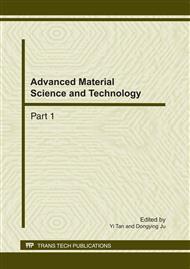p.611
p.615
p.619
p.629
p.633
p.639
p.643
p.647
p.651
Research on the Self-Thickening Effects in the Process of Fabricating Aluminum Foam Using Semi-Solid Melt by Mechanical Stirring
Abstract:
This paper investigated the self-thickening effects on fabricating close cell aluminum foam directly using semi-solid melt by mechanical stirring without adding other particles. Using the high viscosity character of semi-solid melt as well as mechanical stirring technique, blowing agents (TiH2) could be homogeneously distributed without other thickening additions such as CaO or TiC which were commonly used to thicken aluminum melt in metal foam industry. It was observed that the semi-solid melt could reach a proper condition for the blowing agents to separate and foam after self-thickening process and the solid fraction played a key role in self-thicken effects compared to the stirring time and speed. The self-thickening effects could meet the purity requirement of melt as well as to fabricate aluminum foam with small pores and good structure using precursors. Aluminum foam was a multi-functional material with features of ultra-light, high-toughness, impact resistance, high specific strength, high specific stiffness, heat isolation and fire retardant [1]. The viscosity of melt was extremely important in the process of fabricating aluminum foam. Jin.I and Kenny.LD did some research on the effects of adding solid particles to thicken the melt and their study showed that the best thickening effect could be obtained when the particle size of 5-20 mm and the proportion of 10~20% of liquid aluminum [2]. Miyoshi.T also did some research on the stirring time in the thickening process and showed that adding Ca particles of 1.5~3%(wt) could effectively controlled the viscosity [2]. Research by J.Banhart showed shat 1-5 %(wt) Al2O3 and SiC adding particles could also thicken the semi-solid melt very effectively[3] [4]. Berry.CB and Hall.CG’s research showed that blowing air, oxygen or other gases could also reach thickening effect [2]. There were several methods to thicken the melt but the same ultimate goal was to obtain a suitable melt environment for distribution and foaming of blowing agents. This paper mainly investigated the effects of the self-thickening semi-solid melt on the distribution behavior of blowing agents. Taking the advantage of the high viscosity of semi-solid melt as well as mechanical stirring technique, without adding other thickening particles, blowing agents (TiH2) could be homogeneously distributed in the semi-solid melt. The parameters such as solid fraction, stirring time and speed were investigated in this paper.
Info:
Periodical:
Pages:
633-637
Citation:
Online since:
February 2011
Authors:
Keywords:
Price:
Сopyright:
© 2011 Trans Tech Publications Ltd. All Rights Reserved
Share:
Citation:


